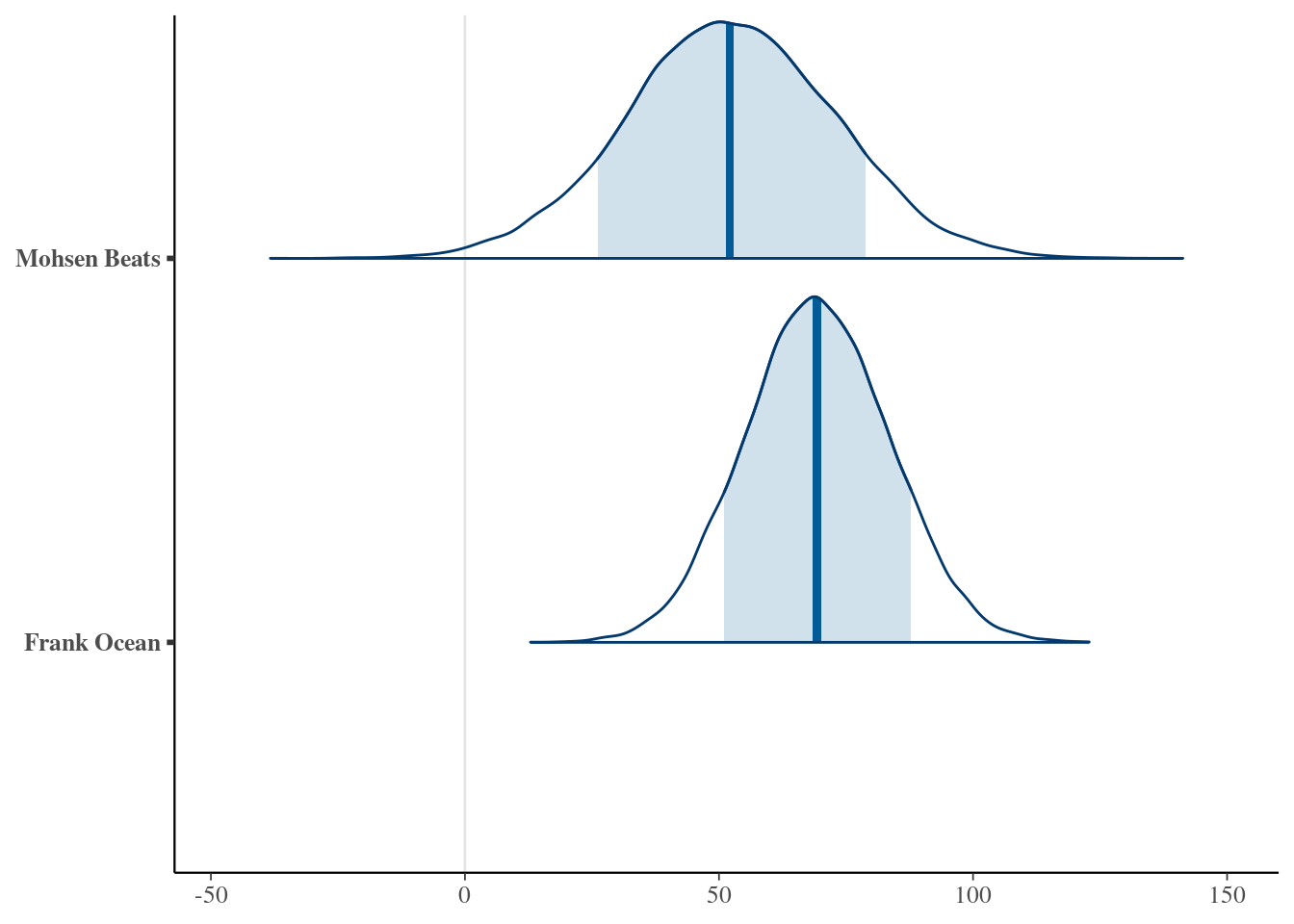16.5 Posterior prediction
What will be the popularity of new song of artist j (two cases: artist in the data / unknown artist)?
posterior_predict() exist but first we do it by “hand”!
16.5.1 First case: Frank Ocean (j=39)
\[Y^{i}_{new,j} | \mu_j, \sigma_y \sim N(\mu_j^{i}, (\sigma^{(i)}_y)^2)\]
We have plenty of \(\mu^{i}_j\) and \(\sigma^{(i)}_y\) with two sources of variability :
Not all song of Ocean are eqully popular (within-group sampling variability)
we do not know the exact mean and variability of Ocean song (posterior variability)
# Simulate Ocean's posterior predictive model
set.seed(84735)
ocean_chains <- spotify_hierarchical_df |>
rename(b = `b[(Intercept) artist:Frank_Ocean]`) |>
select(`(Intercept)`, b, sigma) |>
mutate(mu_ocean = `(Intercept)` + b,
y_ocean = rnorm(20000, mean = mu_ocean, sd = sigma)) # stuff that I always forget
# Check it out
head(ocean_chains, 3)## (Intercept) b sigma mu_ocean y_ocean
## 1 49.93503 18.01483 14.51838 67.94986 77.63700
## 2 49.20877 19.15738 13.47368 68.36615 66.69757
## 3 51.66700 19.05753 14.27727 70.72453 81.87319Then you summarize it:
ocean_chains |>
mean_qi(y_ocean, .width = 0.80) ## # A tibble: 1 × 6
## y_ocean .lower .upper .width .point .interval
## <dbl> <dbl> <dbl> <dbl> <chr> <chr>
## 1 69.4 51.4 87.6 0.8 mean qi# to put into context
# the range of a new song is wider tham the average of ocean
artist_summary_scaled |>
filter(artist == "artist:Frank_Ocean")## # A tibble: 1 × 7
## artist mu_j .lower .upper .width .point .interval
## <fct> <dbl> <dbl> <dbl> <dbl> <chr> <chr>
## 1 artist:Frank_Ocean 69.4 66.6 72.2 0.8 mean qi16.5.2 Posterior prediction for an observed group
We do not have \(\mu_j\) but we know new artist is an artist! And we now the range of mean popularity level among artist \(N(\mu, \sigma_u)\) and we have 44 artists.
step 1: simulate \(\mu_{new_artist}\) bt drawing into layer 2 of MCMC
step 2: simulate song popularity with Layer 1 and \(\mu_{new_artist}\)
We are adding a new source of variability (not all artist are equally popular : between group)
set.seed(84735)
mohsen_chains <- spotify_hierarchical_df |>
mutate(sigma_mu = sqrt(`Sigma[artist:(Intercept),(Intercept)]`),
mu_mohsen = rnorm(20000, `(Intercept)`, sigma_mu), # new stuff
y_mohsen = rnorm(20000, mu_mohsen, sigma))
# Posterior predictive summaries
mohsen_chains |>
mean_qi(y_mohsen, .width = 0.80)## # A tibble: 1 × 6
## y_mohsen .lower .upper .width .point .interval
## <dbl> <dbl> <dbl> <dbl> <chr> <chr>
## 1 52.3 25.9 78.8 0.8 mean qi16.5.3 posterior_predict()
set.seed(84735)
prediction_shortcut <- posterior_predict(
spotify_hierarchical,
newdata = data.frame(artist = c("Frank Ocean", "Mohsen Beats")))
# Posterior predictive model plots
mcmc_areas(prediction_shortcut, prob = 0.8) +
ggplot2::scale_y_discrete(labels = c("Frank Ocean", "Mohsen Beats"))## Scale for y is already present.
## Adding another scale for y, which will replace the existing scale.